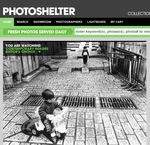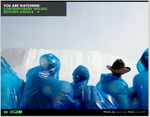Sifting Through the Debris of PhotoShelter's Collection
"Ok, so this picture is a metaphor of-sorts," began Rachel Hulin in her last post for PhotoShelter. "You see, those are beautiful balloons. And we had a wonderful New Year's. But eventually the balloons floated to the floor. And then the cats ate them.
"And it's with this bit of knowledge that I sadly depart as stewardess of Shoot! the Blog."
Hulin is among a sizable group of employees let go following PhotoShelter's recent decision to shut down its Collection marketplace. The news was announced yesterday -- and it came as a total surprise to both image-buyers and photographers.
The Collection enabled image buyers to find more candid photos than they normally would on Getty, while paying less along the way. And photographers received a higher cut for photos and had a team of sales people marketing their work.
The service is about a year old. When I attended PhotoShelter's Shoot! the Day conference in July, indie photographers and image buyers seemed stoked about it. They evangelized, formed personal relationships with PhotoShelter's team, and even took more photographs themselves.
Which led me to wonder -- how could this service have died quietly in the night?
Yesterday afternoon I spoke with VP Andrew Fingerman of Marketing at PhotoShelter. Here's what he had to say about the demise of a program the company hoped would "change the industry."
AF: "We started the Collection with the ambition to change the industry. Doing that meant we were gonna do things differently than what's currently out there, and by that I'm referring to Getty."
Andrew describes how PhotoShelter provided bigger revenue splits for photographers, as well as educational opportunities like Shoot! the Day and School of Stock. The PhotoShelter website also gave photographers the chance to communicate directly with buyers.
Adrants: Did you get the response you expected from the industry?
AF: The community built quickly from zero sales a day to many sales a day. But sales weren't increasing quickly enough to meet our goals ... and to meet investor goals specifically for this product line.
Adrants: How did rivals affect the Collection's trajectory?
AF: "Getty has a subscription-based model." Note: PhotoShelter's CEO says that because subscriptions emphasize convenience, they look good to image buyers but are ultimately bad for photographers. "Buyers subscribe to it immediately because it's the biggest." Convincing them to buy photos outside their subscription with Getty was difficult.
Adrants: Did you consider adopting a subscription model?
AF: "Yes, but the problem with that is [...] the photographer gets screwed. Royally screwed. In the end they'd be getting pennies on the dollar for each sale." This perpetuates the "squeezing of the photographer that we set out to stand against."
In the end, PhotoShelter felt it had would have to forsake its goal of changing the industry just to remain competitive. "Philosophically we just wouldn't do that," Andrew said.
Shortly after talking to him, I got an email from Molly at WanderingPondering.com, a casual photographer and image buyer. She asked if I heard about PhotoShelter's decision to shut down the Collection, whose model she called "inspiring."
We discussed a few things Andrew said in brief. Molly immediately disagreed with PhotoShelter's tragic hero stance. "Adjusting the photographer/agency cut slightly or creating an area for cheaper images wouldn't have compromised their message," she argued.
Given PhotoShelter's commitment to photographer/buyer transparency, its refusal to discuss the problem until it couldn't be solved also perplexed us. It should have reached out to its community, at the very least to solicit them for ideas or gather feedback on moves they were considering.
"Despite the many challenges they faced [...] I think people were rallying for their success and rooting for the underdog AND they would have eventually
succeeded," Molly added, concluding this cop-out was "like running 25 miles of a
marathon after 6 months of training while all your friends are rooting for you." Read her complete thoughts.
Moving forward, PhotoShelter will focus its Personal Archive product. At first glance it seems a lot like flickr, but Andrew says you can store photos without them being compressed, sell them, and add watermarks. These features can be embedded directly onto photographers' personal websites.
Updates to the Personal Archive will go live in coming weeks, which PhotoShelter hopes will demonstrate their commitment to stick around long-term.
Despite the glimmer of light ahead, shutting down the Collection is a big job -- and it's hardly finished. The entire Collection team -- including photo editors, sales, and PhotoShelter's blogger Rachel Hulin -- was let go. That's the kind of thing that tarnishes the spirit of a young company.
Andrew agrees the vibe won't be the same. "We're losing a lot of people we saw everyday and care about," he acknowledged.
He also admitted the Collection was difficult to maintain, and nobody really got much sleep amidst efforts to keep it afloat. With a tired sigh, he concluded, "I'm really looking forward to Monday. Monday is when we get to say 'that chapter is closed, and now we're 100 percent focused on personal archives and innovation.'"
PhotoShelter's Collection officially shutters on October 10.
UPDATE: Responding to Molly's comments in this article, PhotoShelter's Andrew Fingerman writes:
Molly's comments prove the exact point I was trying to make. Buyers loved us. They found us inspirational. They loved what we were doing for photographers. But at the end of the day, they were not buying from us.







Comments
Rachel's great blog continues at www.rachelhulin.com/blog